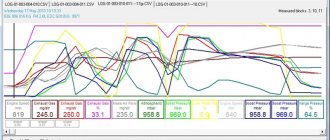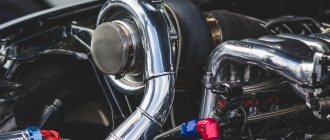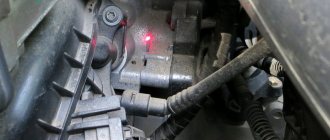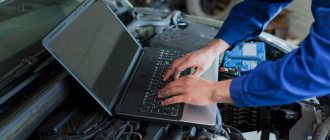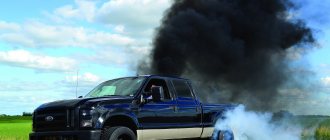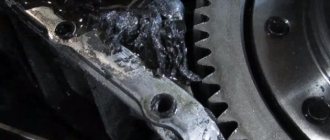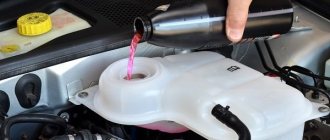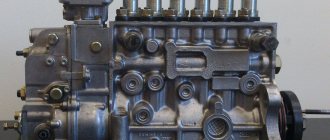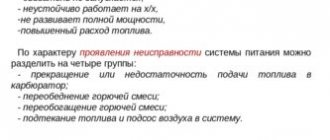A turbine is a complex power-injecting device. Unlike many other components of a modern car, its malfunction is not critical. However, it must be clarified that in this case there will be no normal operation, and the leakage of expensive oil and fuel will seriously hit the owner’s pocket. What signs of a diesel engine turbine malfunction can you detect on your own?
To begin with, it should be noted that the typical manifestations of a diesel turbine failure are very similar to the failure of other units and systems. Therefore, to accurately determine the cause of the appearance of a particular factor, it is necessary to carry out high-quality diagnostics using special stands and measuring instruments. An ordinary car enthusiast cannot do without contacting a service station.
Characteristic signs and possible causes
Often there is a combination of several obvious manifestations of a breakdown, but sometimes only one is observed. The malfunction can be determined by the following phenomena:
- increased oil consumption and leakage;
- change in color and visual increase in the amount of smoke;
- engine noise;
- temporary or permanent overheating;
- noticeable decrease in power and speed of acceleration;
- increased fuel consumption;
- increased emissions of harmful substances from the exhaust system and toxic odor;
- whistling or scratching in the turbine itself;
- floating idle.
The appearance of any of these items requires attention from the owner, prompt diagnosis and repair of the breakdown. The fact is that the lion's share of problems with diesel turbines, one way or another, relates to leakage and oil consumption. When it ends, the work surfaces will begin to wear off. To completely fail this mechanism, it is enough to work for just a few seconds without a lubricant. After this, restoration and repair will become impossible, all that remains is a complete replacement, and this is not cheap.
Symptoms of a dying turbine: how to determine the immediate need to replace a part
A turbine, like any other car spare part, eventually requires diagnostics, repair or complete replacement, but unlike a punctured wheel or a sputtering engine, it does not immediately indicate breakdown or wear. The symptoms of a dying turbine are not easy to recognize, so it is important to try to take a set of measures to increase the life of the part. These actions include: replacing high-quality synthetic oils (every 10,000 km), timely replacement of the air filter (original or high-quality analogue), using a turbo timer, and also monitoring the engine oil level using a dipstick.
Smoke color and exhaust smell
The appearance of smoke in the exhaust system immediately draws attention. This is often accompanied by an unpleasant chemical odor that can be heard even while driving.
Black smoke
This phenomenon means the combustion of the fuel mixture in the turbine. The problem is caused by a lack of air in the fuel system. Need to check:
- tightness of connections of all pipes;
- ECU;
- air filter (most often this is the cause);
- performance of the fuel system;
- engine.
Bluish-gray color
In this case, oil enters the engine. Obviously, the reason lies in the leak. It is necessary to inspect all connections, and the reason lies in problems with the turbine or engine.
Milky white color
Most often this happens when the oil drain line is clogged.
What is the situation with the diesel power unit?
The situation with a gasoline car is practically no different from how a diesel turbine dies . In this case, the exhaust smoke becomes blue or white as the car accelerates. You can also easily find out the malfunction by black smoke, which will appear due to air leaks in the injection paths or a faulty fuel system. White smoke and the smell of oil from the exhaust system will indicate an oil leak into the exhaust system, this happens when increased axial play appears in the turbine, the retaining ring does not hold oil pressure! If the turbine drives oil into the exhaust, oil deposits appear on the hot turbine wheel, which leads to imbalance of the turbine and further destruction of the bearing housing!
If you have figured out how to understand that the turbine is dying , you also need to remember a few basic nuances of the test. A visual check will rarely allow you to determine the malfunction, because only a professional can determine the basis of the breakdown.
Signs and malfunctions of a turbocharger
- Blue exhaust smoke is a sign of combustion of oil in the engine cylinders, which got there from the turbocharger or engine. Black means there is an air leak, while white exhaust gas indicates a clogged turbocharger oil drain.
- The cause of the whistle is an air leak at the junction of the compressor outlet and the engine, and the grinding indicates the rubbing elements of the entire turbocharging system.
- It is also worth checking all the elements of the turbine on the engine if it turns off or stops working .
There are three reasons behind all turbocharger malfunctions
Lack and low oil pressure
Occurs due to leakage or pinching of oil hoses, as well as due to their improper installation to the turbine. Leads to increased wear of the rings, shaft journal, insufficient lubrication and overheating of the turbine radial bearings. They will have to be changed.
Oil contamination
This happens due to untimely replacement of the old oil or filter, water or fuel getting into the lubricant, or the use of low-quality oil. Leads to bearing wear, blockage of oil channels, and damage to the axle. Faulty parts should be replaced with new ones. Thick oil also harms bearings, as it produces sediment and reduces the tightness of the turbine.
Foreign object entering the turbocharger
Leads to damage to the compressor wheel blades (therefore, air pressure drops); turbine wheel blades; rotor. On the compressor side, you need to replace the filter and check the intake tract for leaks. On the turbine side, it is worth replacing the shaft and checking the intake manifold.
Structure of a car engine turbine: 1. compressor wheel; 2. bearing; 3. actuator; 4. oil supply fitting; 5. rotor; 6. cartridge; 7. hot snail; 8. cold snail.
Oil leaks
If, upon inspection of the turbocharging system, small oil stains are found, the unit must be replaced. This means that it has lost its seal and the oil is being squeezed out through the seals.
Typical damage to the impeller wheel and shaft is caused by the so-called turbine torsion, that is, exceeding the permissible speed. It occurs due to false readings from the air flow sensor. The boost pressure control mechanism operates with a delay, the temperature rises, and the technical unit is deformed.
Article on the topic
How to “kill” a box? Errors leading to breakdown of a mechanical transmission Pressure drops can result from clogging of the air supply channel, coking of the turbine shafts or clogging of the oil drain line.
Thus, if at least one of these symptoms is present, then it’s time to send the car for diagnostics. A computer connected to the connector will analyze the errors in the intake system and display a list of faults.
Is it possible to repair the turbine yourself?
The design of the turbocharger seems simple and straightforward. And all you need to repair a turbine is to know the turbine model, engine number, as well as the manufacturer and have spare parts or a factory repair kit for turbines on hand.
You can independently carry out visual diagnostics of the turbocharger, dismantle it, disassemble and replace defective turbine elements, and install them in place. Inspect the air, fuel, cooling and oil systems with which the turbine closely interacts, check their operation.
Turbochargers for gasoline engines
The operating principle of turbochargers for gasoline automobile engines is the same as for diesel engines for general use. Therefore, this chapter should be considered as a continuation of previous descriptions of turbochargers for general purpose diesel engines and automobile engines.
When installing a turbocharger on a gasoline engine, specific requirements arise.
Ensuring the tightness of the oil and gas channels of the turbocharger
Preventing compressor-side oil leaks with a gasoline engine is sometimes much more difficult than with a diesel engine, especially if the throttle body is mounted before the turbocharger. In this case, a strong vacuum forms in the compressor, causing oil to be sucked into the housing. Garret has developed a carbon fiber O-ring that is used on T2, T25 and T3 automotive turbochargers. The carbon o-ring presses against the back of the compressor impeller and provides a seal. True, part of the mechanical energy of the turbocharger is lost. This design is used only if it is really necessary.
The high tightness provided by the ring on the compressor side is also necessary if a fuel-air mixture forms before the turbocharger inlet. In this case, the seal must prevent the mixture from entering the engine crankcase through the axle housing, which could cause a fire or damage to the latter.
In cases where high tightness is not required, the same sealing system is used as in a compressor for a diesel engine.
Compared to a diesel engine, the exhaust gas temperature of a gasoline engine is higher, so additional thermal insulation measures are required.
Quality of turbine materials
The turbine housing, as well as its rotor, is made of high-quality materials characterized by high heat resistance.
Some types of turbine rotors for turbochargers of gasoline engines are identical in shape and manufacturing technology to those intended for small diesel engines. To avoid possible identification errors, Garrett introduced a distinctive feature: a special shape of the rotor end (see Fig. 88 and 89).
Control valve
The increased temperature in the turbine is also taken into account when designing the control valve.
When the valve is installed directly on the turbine housing, the heat transfer from the valve to the actuator diaphragm is so great that the diaphragm is damaged.
There are two solutions to the problem. First, you can move the valve away from the turbine. This solution is used by KKK because it also allows for more precise adjustment. But it is also the most expensive option, which means it can only be used on high-end cars. Another solution is a completely different design that does not use control valves. The simple poppet valve is replaced by a flapper located in the exhaust system, which is actuated by a diaphragm connected to the compressor (see Fig. 91). Control occurs through rods, which is an obstacle to the transfer of heat to the membrane, thereby preventing its damage. The disadvantage of such a rod system is that there may be play between the individual elements. Therefore, when adjusting, the valve will operate with some tolerance. In practice, this solution is most often used, because this design is lighter, more compact, and also cheaper.
Cooled axle housing
The axle housing has undergone many changes. First of all, the oil volume in the axle housing was increased and temperature elements were built in between the turbine and compressor.
The next stage of development was to increase the mass of the metal simultaneously with the appearance of external cooling fins.
However, the danger of heat transfer from the turbine to the axle housing remained high, especially when operating at high speeds.
When the engine stops and oil circulation stops, heat removal also stops. The remaining oil in the axle housing becomes coked, and these deposits damage the housing. To solve this problem, housings were developed that were cooled by both oil and water.
The axle housing water cooling system is connected to the engine cooling system. Since the latter is of a closed type, the housing contains coolant even after the engine is stopped. In addition, to briefly continue the circulation of liquid after stopping the engine, a small pump can be additionally built in. In this way, excessive heat after the engine has stopped can be dissipated.
Preventing turbine breakdowns
To extend the life of your turbocharger, follow these simple rules:
- Change air filters promptly.
- Fill with original oil and high-quality fuel.
- Completely change the oil in the turbocharging system after every 7 thousand km .
- Monitor the boost pressure.
- Be sure to warm up a car with a diesel engine and turbocharger.
- After a long drive, allow the hot engine to cool down by idling for at least 3 minutes before turning it off. There will be no carbon residue that harms the bearings.
- Carry out regular diagnostics and ensure professional maintenance.
Turbocharged engines are rapidly gaining popularity. If previously turbochargers were installed in heavy or powerful sports cars, now turbines can be seen in passenger cars, both with a gasoline engine and a diesel one.
Diesel engine turbines usually have a service life much shorter than that of the engine itself. In order to carry out preventive maintenance on time and not face the need to pay for expensive parts, you need to periodically check the operation of the turbine. This can be done independently, without contacting a car service.
How to properly check a turbine on a diesel engine?
- According to the rules, the turbine must be checked at a service station using special equipment; the air pressure sensor is checked first. Often the cause of a faulty turbine lies in this sensor. Using a special connector, a diagnostic device is connected, after which information about the operation of the sensor is read.
- The second step is to check the output from the turbocharger, connect a special device with a pressure gauge to it, then take measurements. Based on the measurement results, the technician makes a conclusion about the serviceability or malfunction of the diesel engine turbine.
Causes of malfunction
In order to inspect the turbine and identify a malfunction, it is necessary to understand what kind of breakdowns can occur in the turbocharger system.
Usually the most problematic elements are seals and bearings. Wear of these parts may cause backlash, noise, and you may encounter a turbine wedge. Operation may be disrupted due to a malfunction of the lubrication system, ventilation valves, or the piston rings are already sufficiently worn out. In this case, diesel fuel combustion products enter the crankcase and lead to negative consequences.
If smoke is noticed in the exhaust, most often blue, then you should pay attention to the PCV valve. Its incorrect operation increases the oil pressure in the turbine, which causes the lubricant to press through the seals. Once outside or into the forced air, the oil changes the composition of the mixture, causing the engine to significantly lose power and begin to emit the aforementioned smoke.
List of reasons for turbine failure:
1.Oil contamination
Fine particle contamination may not be visually detectable. The particles polish the bushings and round their edges. Bushings often wear out along their outer diameter.
Large particle pollution. Large particles carried by the oil cause deep grooves in the bushings. The inner surface of the bushing also wears out, but to a lesser extent. The middle body and shaft are smaller due to the hardness of the material. Damage to the shaft is caused by the same large particles found in motor oil.
Dirt entering the turbine lubrication system leads to deep scratches on the TKR shaft and plain bearings. To avoid such problems, the oil and filter must be of the quality recommended by the engine manufacturer (OEM). Be sure to change the oil and filter when installing a new turbine, as well as at the intervals recommended by the vehicle/engine manufacturer.
Oil contamination can result from:
- Dirt got in during repairs.
- Engine wear.
- The oil bypasses the filter (the oil filter bypass valve is faulty).
- Low quality oil.
- The oil filter is clogged or the filtration quality is poor (poor quality filter).
Why does contaminated oil harm the turbocharger?
As the turbocharger rotor spins at speeds of up to 240,000 rpm and is exposed to temperatures of up to 950°C, the turbine bearings are subject to enormous stress. Contaminated oil will have an abrasive effect on the bearings, leading to rapid wear and, ultimately, to the fact that the turbine blades will touch the housing and be destroyed.
You may ask: how can the oil be contaminated if I change it and all filters every 10 thousand kilometers? After all, all the chips should remain in the filter? This is a valid question, let's look at the problem in more detail.
The fact is that there is a pressure reducing valve in the lubrication system. This valve opens when the oil is thick and cannot pass through the oil filter. Therefore, the oil goes past the filter and goes straight into the engine. Thus, before the engine warms up and the oil becomes liquid, it simply is not cleaned. And all engine wear products enter the turbine along with the oil and lead to its wear. Therefore, you should not give the engine maximum loads without warming it up. This is especially true in the cold season. In addition, you need to choose a good oil that will be stable in viscosity over a wide temperature range, and also use high-quality filters.
Lack of lubrication
If the oil supply to the turbocharger is limited for a long time (more than 10 seconds), scratches and burns will appear in the turbine bearing system.
This will also be manifested by characteristic discoloration of the shaft and shaft neck as shown below. This type of failure is known as oil starvation. Insufficient lubrication occurs when the oil passage is restricted by gasket material or sealant. Characterized by a strong discoloration of the turbine shaft.
Complete lack of lubrication. Looks even more terrifying than in the photo. Leads to turbine failure very quickly.
Oil starvation can be caused by the following reasons:
- 1. Incorrect installation of the turbocharger.
- 2.The oil supply/discharge tube is damaged (jammed).
- 3.Low oil pressure due to a failure in the lubrication system.
- 4.Low engine oil level.
- 5. Blockage due to the use of sealant when connecting the oil supply pipe.
- 6. Oil pump failure.
- 7. Air entering the lubrication system.
- 8.Use of incorrect gasket that restricts oil flow.
The rotor shaft and bearings rotate in a thin oil film. If there is no oil at startup or during operation of the turbocharger, the bearings will certainly fail. Five seconds of operation without oil is as harmful to a turbine as five minutes without lubrication to a motor. It is important to ensure that the pressure in the engine lubrication system meets the manufacturer's specifications. But it is even more important to check that the oil supply pipes are clear of contaminants and can supply oil at the required pressure.
Chemical contamination of oil.
Chemical contamination is the cause of high wear on the support shaft and overheating. The visual signs are almost the same as those caused by insufficient lubrication. The usual cause is oil dilution by the fuel, which reduces the lubricating properties of the oil.
Extreme operating conditions.
A typical malfunction is high temperature on the plain bearings (bushings).
In the photo, the oil burned and coked the turbine shaft. Often the back of the turbine shaft bends slightly, usually accompanied by an “orange peel” effect and is a very clear indication of over-twisting and over-blowing. Torsion can lead to the loss of part of the turbine shaft blades. The damage may look like a foreign body entering the turbine part.
What causes "twist"?
- 1. Clogged air filter or intake pipe. A cracked or disconnected hose that is delivering the wrong amount of air to the turbocharger.
- 2. A “chip” engine that does not meet standard specifications.
- 3.Adjusted bypass valve.
- 4. Wear of injectors.
- 5. Loss of signal from the electronic control unit for the bypass valve or adjustable nozzle apparatus (PCA)..
- 6. Installation of a non-standard turbocharger.
In extreme cases, the shaft may rupture due to torsion. Minute stress leads to the appearance of cracks, which increase with each twisting cycle and ultimately lead to rapid rupture of the turbine shaft.
High speed, load and temperature - typical high temperature damage - on the journal of the shaft, usually oil deposits and coking of the shaft. Often the rear surface of the turbine wheel is slightly concave, usually accompanied by an "orange crust" on the rear of the compressor wheel - a very sure sign of over-speeding and excessive load. Driving at excessive speed can also cause the turbine blades to lose part. May appear similar to foreign object damage, but is often accompanied by a crack at the base of the blade and in extreme cases, the wheel may break due to speeding. Short-term overloads cause cracks to appear as the wheel “stretches” beyond its design limits. The cracks increase with subsequent overloads, ultimately leading to rapid failure.
Damage from foreign bodies.
The result of damage due to foreign objects entering the turbine or compressor volute can be clearly seen by visual inspection.
Solid foreign body in the compressor. This damage is caused by a foreign body entering the compressor part. Traces of its influence are visible on the compressor scroll. Salt and sand lead to erosion and corrosion of compressor wheel blades.
A soft foreign body such as rags or paper can cause this failure. It is common for compressor wheel blades to become bent, and in extreme cases the blades may break off.
A solid foreign body that gets into the turbine part breaks off the turbine shaft blades. Even small objects such as scale from the exhaust manifold can cause significant damage to the turbine shaft blades due to the high rotation speed.
In case of mechanical damage, before installing a new turbocharger, it is necessary to check and remove all particles from the engine systems:
- 1.Check the air filter and all pipes of the engine intake system. exchange of turbochargers, turbochargers
- 2.Check the intercooler and intake manifold, as well as all pipes from the compressor.
- 3. Find the source of the foreign object.
Excessive temperature. Overheat
Most often, the turbocharger lubrication system is combined with the engine lubrication system.
Engine oil is used both as a turbine lubricant and as a coolant. Overheating occurs when the engine is stopped after running under heavy load. When the engine is stopped, oil circulation stops. This causes the turbine to stop cooling and the small amount of oil remaining in the very hot turbine to become coked. High temperatures (800-1000°C) of exhaust gases passing through the turbocharger create conditions for oil coking and wear of the bearing system. The main damage occurs to the oil seal of the turbine part, then the ring cuts into the shaft, impeller and bushing (bearing) of the turbine part. The ability to pass oil into the bearings through the oil passages will be reduced by coked oil.
Also, when overheated, wear on the thrust bearings increases and through cracks may appear in the turbine wheel housing. Reason: Overheating of the housing (late ignition, lean mixture, injection timing). When repairing, the housing must be replaced with a new one.
We recommend that before turning off the engine, let it idle for 2-3 minutes to cool the system.
Causes:
- 1. Clogged air filter, or excessive intake resistance.
- 2.Stopping a hot engine.
- 3. Low quality oil, not resistant to coking.
- 4.Irregular oil changes.
- 5. Air or gas entering the system.
- 6. Faulty injection pump or injectors.
- 7. Incorrect installation of the turbine.
- 8.No oil supply.
- 9.Excessive loads and extreme operating conditions.
Failure of the electronic variable geometry drive.
Turbochargers with VNT (Variable Nozzle Turbine) system are designed to achieve high engine power ratings and fast response at low speeds.
The latest VNT turbine models use fully electronic control of the guide vanes, which provides:
- 1.Quick response.
- 2.Accuracy.
- 3. Feedback from the electronic engine control unit (ECU).
- 4. REA/SREA malfunction.
The movement of the blades is controlled by REA (Rotary Electronic Actuator) or SREA (Simple Rotary Electronic Actuator). Symptoms of a malfunction (or obvious breakdown) of the drive:
- 1. Errors recorded by the engine ECU.
- 2. Insufficient boost pressure.
- 3. Excessive boost pressure.
- 4.Noise.
Malfunctions caused by incorrect operation of the engine vacuum system.
Variable geometry turbines can be controlled via the engine vacuum system, which contains solenoid control valves.
Failure of such a valve can lead to turbine and engine failures. Therefore, if you suspect improper operation of a turbine or engine, you should always ensure that the control valve is operating correctly. This can be done by diagnosing it using special equipment. A faulty valve may be clogged, in which case it can be cleaned or completely replaced. In addition, the problem may not be in the valve itself, but in the wiring going to it or in the electronic control unit for the vacuum system.
All this needs to be checked before starting to repair the turbine.
EGR valve failure
The EGR (exhaust gas recirculation) valve redirects a small portion of the exhaust gases back into the intake, which lowers the maximum combustion temperature of the fuel.
The EGR valve closes at idle, otherwise it can lead to instability, and at peak power, when the addition of exhaust gases will cause a loss of dynamics. In some cases, the EGR valve may become clogged. This can have a significant impact on the performance of the turbocharger. A faulty EGR valve can cause excessive soot/coke deposits on the turbine side of the turbocharger. In turn, this will lead to blocking of the VNT mechanism. Therefore, it is important to check that the EGR valve is working correctly. If the EGR valve is faulty:
- 1.Excessive nitric oxide emissions. Rough idle or inability to idle.
- 2. Poor operation of a “cold” engine.
- 3.Increased fuel consumption.
- 4. Lack of power.
- 5. Appearance of a malfunction code and/or malfunction indicator light.
Possible reasons why the EGR valve does not open:
- 1. EGR valve is clogged/coked.
- 2. Air leaks into the vacuum part of the valve.
- 3. Vacuum lines are disconnected, leaking, or improperly connected.
- 4. Possible reasons why the EGR valve does not close.
- 5. Hard deposits on the valve stem or valve plate.
The EGR valve is damaged due to overheating due to:
- 1. Incorrect management.
- 2.Increased back pressure in the exhaust system.
- 3. The compressor safety valve does not operate.
- 4. Erroneous signal from the air flow meter or other sensor.
- 5. The EGR system pipe is partially blocked by deposits.
- 6. Oil leak from turbocharger.
- 7.The electrical switch of the pressure converter is faulty.
- 8. The compressor safety valve does not work.
When to check the turbine
If you use high-quality oil and treat the diesel unit with care, the turbocharger will operate properly for approximately 150 thousand kilometers. To detect any breakdown at its initial stage, you need to carefully monitor the turbine; just check the operation of the unit during an oil change.
Thus, the car owner can save significantly by repairing the problem at its initial stage, instead of replacing an expensive part.
What determines the price of repairing a diesel engine turbine at a car service center?
Repairing a turbine on a diesel engine begins with disassembling the compressor. Many novice motorists are sure that this is not difficult to do. However, they are actually wrong. When contacting a car service center, the price for repair work will be higher if you have not a Russian car, but a new foreign car. In addition, when the operation of the turbine is monitored by an electronic computer, repairs will be more expensive, because the technician will need to turn off the control system.
The difficulty of disassembling a turbocharger is determined by its design features. The principle here is the same: the more complex the design of the mechanism, the more expensive the repair. One way or another, a specialist will need to disassemble it, even if this process turns out to be quite lengthy.
The cost of repairing a turbine on a diesel engine also depends on the complexity of the breakdown. Therefore, it is always necessary to understand why repair work is carried out. For example, if it’s time to undergo a technical inspection and also service a turbocharger, then you will pay a small amount for such work. However, when the turbine fails, it needs to be restored, broken parts replaced, or a completely new mechanism purchased; the cost of repairs will be high.
First signs of trouble
Of course, if a car enthusiast does not have experience working with cars, you should not immediately disassemble the unit and try to identify the fault from the inside. There are several signs that indicate the turbocharger is not working properly:
- the appearance of bluish or black smoke during exhaust;
- very loud operation of the diesel unit under various loads;
- the engine often overheats;
- fuel consumption is steadily increasing, as is the rate of oil consumption;
- deterioration of traction, loss of power and dynamics.
What you should pay attention to?
The most obvious signs of a turbocharger malfunction are as follows:
- The exhaust pipe smokes and turns from white to black and dark blue.
- The noise level increases when the motor is running, which can be perceived by ear;
- Pressure pulsation at the turbine outlet or the so-called “surge”, which manifests itself as clear loud pops;
- A drop in traction, deterioration in dynamics, it takes more time to gain momentum. At idle, the engine is also unstable;
- A pungent smell of burnt oil and an increase in its consumption by the car;
- A dull sound, whistling, clicking or other sound under the hood of the car.
But when diagnosing a car with a turbine malfunction, you should not rely only on the above signs; it is better to have the car examined by professionals who will determine the true cause of the problem.
Self check
The initial check can be carried out on your own, so as not to spend money on computer diagnostics, which often costs a lot of money. First, the turbocharger needs to be carefully inspected.
First of all, the level and quality of the engine oil used for the diesel engine is checked. Then you need to make sure that no foreign object has entered the compressor.
After the procedures are completed, it is necessary to evaluate the color of the exhaust. It can also point out specific problems with the turbine. If the exhaust color is black and a drop in power is noticed, then most likely you will have to deal with an over-enriched mixture. It appears due to a breakdown of the air intake-exhaust system. At the intake, insufficient air enters the cylinders, and at the exhaust there may be leaks, which lead to loss of power.
Blue or even white smoke from the exhaust pipe indicates that oil enters the cylinders and then burns in the working chamber. In this case, oil consumption can increase to about a liter per 1000 kilometers. It is necessary to check the operation of the rotor and the cleanliness of the filters. The rotor must have slight play and not touch the housing, otherwise the part requires immediate inspection and repair.
A heavily contaminated filter cannot pass the required amount of air, which creates different pressures in the turbocharger housing and in the cartridge with bearings. From this cartridge the oil enters the compressor. If the problem is not in the filter, then you need to check the entire oil supply system, hoses and pipes for bends, cracks and crevices.
The tightness of the pipe connections can be checked with the engine running. Whistling and creaking, as well as air breaking through the system, indicate that the clamps need to be tightened. Any leak or damage will result in insufficient air supply to the cylinders.
Another cause of turbine malfunction is improper oil drainage due to gases entering the crankcase. It is necessary to check the ventilation system so that the diesel engine does not start to breathe.
How can you tell if a turbine is dying?
In some cases, the death of a turbine occurs at lightning speed - the reason for this may be oil starvation, foreign solid particles entering the compressor wheel from the air duct, foreign solid particles entering the turbine wheel (rotor) with an internal combustion engine, as well as an accident. But more often than not, the turbocharger fails gradually. It is important for the driver to promptly contact a specialized technical center and identify a potential malfunction and take measures to eliminate it. The following are common signs of a dying turbine:
To determine a breakdown in the early stages, you need to listen to your car; if your car does not have enough power, it has become less playful than before, this means that the turbine does not produce the proper pressure. Sometimes the reason for a decrease in this value is increased back pressure, which occurs due to a contaminated catalyst, also a malfunction of the solenoid valve (turbine vacuum control) also contributes to a decrease in power, but if these two parts are normal, you need to check the wastegate or variable geometry ! Most often, during aggressive driving, exhaust gas flows bypass the valve, or damaged variable geometry clings to the turbocharger housing and does not direct air flows to the turbine wheel! In such cases, the turbine is not able to show proper efficiency.
If the problem is not identified, you will have to remove the turbocharger from the power unit! Frequently asked question: how to rebuild a turbine with your own hands . In many cases, it is not possible to repair a turbine on your own! Because the turbine cartridge requires high-precision balancing after overhaul! To do this, you will have to contact a turbine repair company! After balancing the turbine, you need to adjust the Vacuum actuator in relation to the damper or geometry! It is necessary to configure according to factory parameters! If the parameters differ from the factory ones, the turbocharger will either not blow enough, or overblown, which will lead to its rapid destruction!
Checking with the engine running
The easiest way to check a turbine on a diesel engine requires the presence of at least two people.
- Start the engine.
- Locate the pipe between the turbocharger and the intake manifold.
- Pass it on.
- Press the gas for a few seconds.
When the turbine is operating correctly, you will feel that the pipe is noticeably inflated. If this does not happen, various cracks and defects in the collector are possible. You should seek qualified help to troubleshoot the problem.
It is very important to understand that you can carry out diagnostics yourself, but repairs must be entrusted to professionals.
Unqualified intervention can lead to the fact that a small malfunction will lead to the breakdown of the entire part and put the car owner in front of the need to change and repair the turbocharger. It is necessary to contact a trusted service center, where specialists will quickly and efficiently eliminate the malfunction and extend the life of the turbocharger on a diesel engine.
What to check yourself?
Before visiting a service station, in some cases you can carry out basic diagnostics of the car yourself.
- If you detect smoke, then regardless of its color, you need to check the air filter and pipe connections. If a leak occurs, it must be repaired and the filter replaced;
- You can find out how worn the turbine is by lightly turning the rotor: there is little play - everything is in order, and if during rotation the rotor even slightly touches the housing, then the turbine most likely needs to be repaired;
- Explore turbocharging. Open the hood, start the engine and clamp the pipe that leads from the turbocharger to the intake manifold. Another person should accelerate for a few seconds and, if the pipe is inflated by pressure, then everything is normal, if it is sluggish, the turbine requires repair;
- Inspect the turbine itself. There should be no oil or other traces on its surface. If you disconnect the pipe that was pinched in the previous step and traces of oil appear, the turbine most likely needs to be replaced.
